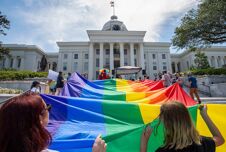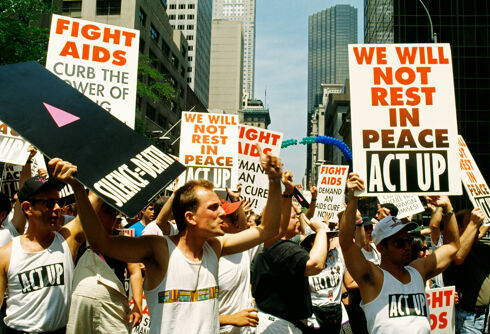“It was a blur, all of it, of faces, and parties, and weekends and storms; it vanished, as did all weeks, months, years in New York in one indistinguishable blur, life speeded up, life so crowded that nothing stood out in relief, and people waited, as they had one autumn weekend here, for a hurricane to provide some kind of sublime climax that never came…” trailblazing author Andrew Holleran writes of one especially eventful summer on Fire Island in his 1978 novel Dancer from the Dance.
It’s hard to think of anyone who has done more to lodge the image of Fire Island as a sort of decadent, gay Shangri-La in the popular imagination than Holleran. The parties, orgies, and the impossibly beautiful men who attend them were all there on the island before Holleran wrote about them in Dancer from the Dance, and they’re all still there today — at least in the summer. And, of course, other tales of delight and debauchery in the Pines and Cherry Grove have since come to life, including Joel Kim Booster’s Jane Austen-inspired Fire Island. But it was Holleran’s description of the revelry, tinged with longing, regret, and wry humor, that elevated Fire Island to the realm of the mythopoetic.
And yet, Andrew Holleran has not been to the storied gay destination off the coast of Long Island, New York, in “absolutely decades.”
“I’m a little superstitious about going back,” Holleran tells LGBTQ Nation by phone from his home in a small town near Gainesville, Florida. “I’ve had opportunities to go back, and I’ve always said I’ll come in the fall or something after the season is kind of ended. It would be fun to take the boat out. I’m sure I’ll do that before I kick the bucket.”
Never Miss a Beat
Subscribe to our newsletter to stay ahead of the latest LGBTQ+ political news and insights.
Holleran, in the years since he’s visited the island, has prepared for the changes that have been made to the harbor where the ferry from Sayville deposits hordes of queer vacationers each summer. But when I mention photos and videos I’ve seen recently on social media of the beach erosion that is bringing waves within feet of some of the island’s stunning multi-million dollar waterfront houses, he’s justifiably alarmed. “So, you’re saying go while it’s still there?”

But at 79, Holleran is not yet at the “revisiting places” stage of his life. He’s similarly superstitious about revisiting his early novels, three of which, Dancer from the Dance, Nights in Aruba, and The Beauty of Men, are being reissued by Harper Perennial this December.
“I’ve always been one of those people who can’t reread his own books,” he explains in his warm, slightly self-deprecating way. “I just become super sensitive to mistakes and things you want to change. And that’s not uncommon. I read about writers who feel that way, so it’s not as crazy as it sounds. You never write the book you dreamed of. It’s just insane. I haven’t written that many books, but even at this point, at an advanced age, I say to myself, ‘You still haven’t written your book! You still haven’t written your book!’ What’s the book? Really, it’s weird. It’s very weird.”
If Holleran hasn’t revisited Dancer from the Dance, a few generations of gay men certainly have. In interviews with the New York Times, William Johnson, PEN Across America’s Director of National Outreach and Engagement and the former deputy director of Lambda Literary, described the book as gay men’s Catcher in the Rye, “the book you read when you’re young.” Tony Kushner has compared it to the work of F. Scott Fitzgerald. Michael Cunningham called it “the first gay novel everybody read … the first Big Gay Literary Sensation.” Generations of gay men continue to post photos of their copies of the various editions on Instagram alongside quotes from the book.
Dancer from the Dance debuted at a time when gay literature began to emerge as a viable subgenre. Prior to 1969’s Stonewall Uprising, queer stories were often coded or obscured, and their characters often relegated to minor roles or tragic ends. But as the gay social scene began to come out of the closet in the 1970s, so did stories about a new kind of gay life.
Holleran and his contemporaries like Edmund White and Robert Ferro — all of whom were associated with the informal group of gay writers that came to be known as the Violet Quill club — paved the way for queer authors to write about queer life in a way they never had before: for queer people, about queer people.
Related:
5 gay authors whose stories show us how to age gracefully
The year provided a remarkably broad and diverse slate of authors sharing points of view neglected in the past by publishing’s traditional gatekeepers.
Dancer from the Dance

Dancer from the Dance was particularly revelatory because it took the gay social scene as its subject, treating it as worthy of examination and reflection, as a legitimate context in which to set a literary novel. As Cunningham wrote in 2018, Holleran’s debut “was not only the first novel about the party” but was also “a novel that chronicled the party’s capacities to transport us to great heights, and (or) to hollow us out.”
The novel’s enduring appeal comes from Holleran’s vivid, evocative depiction of a bygone era: gay New York in the 1970s, before the AIDS epidemic put an end to — or at least severely curtailed for a while — that particularly hedonistic party. The underground parties where disco was just emerging, the baths, the bacchanals, the cruising, the sex, the trips to Fire Island (to this day, Holleran remains puzzled by the fact that the novel is so associated with Fire Island when the bulk of the story takes place in Manhattan) are all recalled in tantalizing, idiosyncratic detail. But it’s the wistful, elegiac quality with which Holleran describes it all that cuts to the bone, that leaves readers not just tantalized but mournful, nostalgic for a way of life that burnt itself out.
Holleran recalls friend and fellow writer Felice Picano telling him that there was something special about the gay 70s in New York. “I would always say to him, ‘Oh, there was nothing special about it. It’s only because we were young,’” he says. “But he thought there was something that had come together in that period. It was a kind of burst of creativity in a lot of fields, and I now think he was right. I think every period has its creativity, but there was something a little extraordinary about that time. And it didn’t last long.”

Holleran was, in a sense, already mourning that world when he wrote the novel. After years in the city, he found himself staying for longer and longer periods with his parents in Florida, particularly during New York’s brutal winters. “I wrote Dancer in the yard,” he recalls. “I remember putting a table out under the trees, and it couldn’t have been less of a New York setting. But that’s where I wrote it, on a brief respite from the life I was leading in the Village.”
“I really think that the five or six years when New York was new, and I was stumbling through it and discovering it, that that’s when all the impressions happened, and after that, it became something of a routine, just as the gay life became something of a routine,” he says. “The discos became bigger and more artfully lighted, and everything became kind of the same thing, just done on a bigger scale. And the magic somehow evaporated.”
Nights in Aruba

While Holleran says Dancer flowed out of him, his second novel, Nights in Aruba, was more of a challenge. “Nights in Aruba was a very painful book for me because it was the second novel,” he says, largely due to uncertainty about what his publisher might want as a follow-up to his debut.
At the time, in the early 1980s, publishers had seen some success with books like White’s A Boy’s Own Story and Ferro’s The Family of Max Desir, and Holleran’s editor suggested that he write about the experience of growing up gay in the American family. “I think they must have thought that if they could get a book about gays in the family, they’d have mainstreamed it more,” he recalls.
Related:
Edmund White witnessed the Stonewall riots, just the beginning of a revolutionary life
The author shares intimate details of his life as a writer and activist, including the new graphic novel adaptation of ‘A Boy’s Own Story.’
Nights in Aruba traces the life of its narrator — who goes unnamed until its final pages — from his childhood on the titular Caribbean island, through his military service in West Germany in the 1960s and his adventures as a young man in New York City in the 1970s, to the early 80s when he is in his late 30s and spending more and more time with his aging parents in Florida. If Dancer borrowed from Holleran’s life in New York, his second novel, published in 1983, is much more nakedly autobiographical.
“When they tell you to write a book about gays and the family, your first impulse is to write about your own because you know it so well,” he explains.
Nights in Aruba is a novel about becoming an adult in a world where few, if any, models for queer adulthood exist. Its narrator has grown weary of, as Holleran put it, the routine of gay life in New York and the perpetual adolescence it seems to enable.
“I had reached the middle period when life — any life: surgeons or housewives, homosexuals or cops — goes stale for a while and one is prisoner of habits that no longer bring happiness, or even pleasure,” Holleran writes. His narrator is stuck in a kind of dual existence: as an out gay man in the city that never sleeps — literally, the narrator struggles with insomnia in his East Village apartment, and as the loving, dutiful son, closeted to his parents. The novel’s ache comes from its narrator’s inability — or unwillingness — to reconcile these two identities and his perception that as a gay man, denied traditional milestones like marriage and having children, his life will have been wasted.
The Beauty of Men

The melancholic undercurrent that tugs at the heart in Dancer, even as its madcap glamor sparks the imagination, is more prominent in Aruba. And it comes even more to the fore in Holleran’s third novel, The Beauty of Men. Set in the mid-80s and once again tracking closely to its author’s own life (last year, in an essay for The New Yorker, author Garth Greenwell wrote that Holleran’s work “can most profitably be read as a sustained study of one man’s life”), the novel explores the isolated life of Lark, a gay man in his late 40s who has retreated to a small town in Florida to care for his quadriplegic mother as AIDS ravages those he knew in New York.
“I’ve always had a chip on my shoulder about the accusation that Dancer was glamorous, and part of me has wanted to write anti-glamorous novels. And Beauty of Men was certainly about that.”
Andrew Holleran
Of Holleran’s three reissued novels, The Beauty of Men is likely to be the most difficult, the most bracing for fans who have only ever read Dancer from the Dance.
“I think you’re right,” Hollerans says at this suggestion. “I think I’ve always had a chip on my shoulder about the accusation that Dancer was glamorous, and part of me has wanted to write anti-glamorous novels. And Beauty of Men was certainly about that. The nursing home, the mother’s situation, being alone, and people are worried about AIDS. So, yeah, it was an anti-glamour response to Dancer, I think.”
Holleran jokes that he’s been living off of Dancer from the Dance ever since it was published. He admits that he hopes the reissues will introduce new readers to Nights in Aruba and The Beauty of Men and that those novels will complicate people’s understanding of his work. He describes Dancer’s status as an indispensable gay classic as “a gift from heaven.” But it also worries him slightly.
“The memorialized quality, the looking back quality, the touchstone quality,” he explains. “It seems to me that if you’re 23 and 25 and 28 in New York right now and you’re gay, there’s got to be a life that is distinctive and unique to your time and your moment. I’m always wanting to find out what it is like now for a young person. And it takes a while for those novels to get written, I think. I never wanted Dancer to be a memorial to the idea that gay life was more exciting or adventurous back then. That would just be depressing, I think.”

















